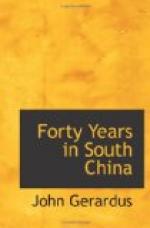It was not so in those early days. The men in Amoy then were men for whom we have to thank God—men ahead of their time, with generous and far-reaching ideas; not working only for their own present, but laying the foundation for a great future. Side by side with him were the brethren of the English Presbyterian Mission, with whom he had the fullest sympathy, and they had the fullest sympathy with him. It is difficult to say who were foremost in pressing the idea of an organized native church. All were equally convinced and strove together for the one great end. After many years of waiting the church grew. Congregations were formed and organized with their own elders and deacons, and in this he took the first steps. He was a born organizer. And then came the next great step, the creation of a Presbytery and the ordination in an orderly manner of native pastors. Some congregations were ready to call and support such pastors, and the men were there, for the careful training of native agents had always been a marked feature of the Amoy Mission. But how was it to be done? Common sense led to only one conclusion. This church must not be an exotic; it must be native, independent of the home churches. And there must be kept in view what was a fact already—the union between the Missions of the “Reformed Church” and of the “English Presbyterian Church.” It must be done, and done in this way, and so it was done.
The Presbytery was created with no native pastor in the first instance, but with native elders and the missionaries of both Missions. Then came a struggle that would have tried the stoutest hearts.
The “Reformed Church” in America declined to recognize this newly-created Presbytery. Dr. Talmage went home and fought the battle and won the day.
To its great honor be it said, the General Synod of the “Reformed Church” rescinded its resolution of the previous year, and allowed their honored brethren, the missionaries, to take their own way. So convinced were the missionaries of the wisdom, yea, the necessity, of the course they had taken, that they were prepared to resign rather than retrace their steps.
But that painful step was not necessary. The Synod of the English Presbyterian Church gave their missionaries a free hand. There is this, however, to be said for the General Synod of the “Reformed Church.” It was only love for their agents and deep interest in this Mission that prompted their original action. They feared that by the creation of this native and independent church court, the tie that bound them to the men and the work might be loosened; and when they saw there was no risk of that, they at once acquiesced. But it was Dr. Talmage’s irresistible pleadings that won their hearts.
The native church has grown. About twenty native pastors have been ordained, settled, and entirely supported by their own congregations. The Presbytery has grown so large that it has to be divided into two presbyteries; and these, with the Presbytery of Swatow, where brethren of the “English Presbyterian Church” are working, will form the Synod of the native Presbyterian Church in those regions of China.




